February/2023 Latest Braindump2go 300-420 Exam Dumps with PDF and VCE Free Updated Today! Following are some new Braindump2go 300-420 Real Exam Questions!
QUESTION 76
How do endpoints inside an SD-Access network reach resources outside the fabric?
A. a VRF fusion router is used to map resources in one VN to another VN
B. Fabric borders use VRFs to map VNs to VRFs
C. SD-Access transit links are used to transport encapsulated traffic from one fabric to another
D. A fabric edge is used to de-encapsulate VXLAN traffic to normal IP traffic then transported over the outside network
Answer: B
Explanation:
Fabric border routers handle the ingress & egress traffic for the SD-Access fabric, they are responsible for translating the policy, VRF & SGT information between the SD-Access fabric and the external networks.
QUESTION 77
Which three pieces of information are carried on OSPF type 3 LSAs? (Choose three)
A. metric
B. authentication type
C. link state
D. IP subnet
E. external route tag
F. subnet mask
Answer: ADF
Explanation:
There is IP prefix (192.168.1.0), Network Mask (/24) and a Metric (10). See below:
R1#show ip ospf database summary
OSPF Router with ID (1.1.1.1) (Process ID 1)
Summary Net Link States (Area 10)
Routing Bit Set on this LSA
LS age: 872
Options: (No TOS-capability, DC, Upward)
LS Type: Summary Links(Network)
Link State ID: 192.168.1.0 (summary Network Number)
Advertising Router: 2.2.2.2
LS Seq Number: 8000000B
Checksum: 0xE0D5
Length: 28
Network Mask: /24
TOS: 0 Metric: 10
QUESTION 78
Which two statements about DMVPN with NHRP are true? (Choose two)
A. NHRP shortens the configuration of the hub router.
B. NHRP dynamically provides information about the spoke routers to the hub.
C. NHRP disables multicast
D. The hub router uses NHRP to initiate the GRE tunnel with spokes.
E. The spoke routers act as the NHRP servers.
Answer: AB
Explanation:
https://www.cisco.com/c/en/us/support/docs/security-vpn/ipsec-negotiation-ike-protocols/41940-dmvpn.html#dyntun
Dynamic Tunnel Creation for “Spoke-to-Hub”
Configuration of the hub router is shortened and simplified since it does not need to have any GRE or IPsec information about the peer routers. All of this information is learned dynamically via NHRP.
D is wrong box spokes are the devices who initiate the tunnel using NHRP not the HUB
QUESTION 79
In a simple MPLS L3VPN, which two tasks are performed by the PE router? (Choose two.)
A. It establishes pseudo wires with other PEs.
B. It exchanges VPNv4 and VPNv6 routes with CE Devices.
C. It assigns labels to routes in individual VPNs.
D. It forwards labeled packets to CE devices.
E. It exchanges VPNv4 or VPNv6 route with other PE routers.
Answer: CE
QUESTION 80
Refer to the exhibit. Which action would make the router the active VRRP router?
A. Recover interface Serial 1/0.
B. Increase priority in the configuration to 100.
C. Change the interface tracking priority to 100.
D. Recover interface Serial 1/1.
Answer: A
Explanation:
As VRRP Group 30 is configured with preemption all that is required is that the VRRP Priority be higher than that of the current active VRRP router and the current master router priority is 50.
QUESTION 81
Which design principle involves redundancy through hardware, software, and connectivity?
A. Performance
B. Security
C. Scalability
D. High availability
Answer: D
QUESTION 82
NAT-PT translates between what address types?
A. RFC 1918 private addresses and public IPv4 addresses
B. IPv4 and IPv6 addresses
C. Network addresses and IPv6 ports
D. Private IPv6 addresses and public IPv6 addresses
Answer: B
QUESTION 83
By default, if IS-IS is enabled on all routers, and this is an IPv6 network, what path is taken?

A. Path 1
B. Path 2
C. Unequal-cost load balancing with Path 1 and Path 2
D. Equal-cost load balancing with Path 1 and Path 2
Answer: A
QUESTION 84
How many host addresses are available with a Class B network with the default mask?
A. 63,998
B. 64,QQQ
C. 65,534
D. 65,536
Answer: C
QUESTION 85
A packet sent to a multicast address reaches what destinations?
A. The nearest destination in a set of hosts
B. All destinations in a set of hosts
C. All hosts
D. Reserved global destinations
Answer: B
QUESTION 86
What does a hierarchical EIGRP design help with? (Choose two.)
A. Redistribution
B. Route summarization
C. Faster convergence
D. Load balancing
Answer: BC
QUESTION 87
During the integration of ISE and DNA Center, which of the following are used to establish trust through ISE?
A. REST APIs
B. pxGRID services
C. Scalable groups
D. SGACLs
Answer: B
QUESTION 88
In IS-IS networks, the backup designated router (BDR) forms adjacencies to what router or routers?
A. It forms an adjacency only with the DR
B. It forms adjacencies with all routers
C. The BDR only becomes adjacent when the DR is down
D. There is no BDR in IS-IS
Answer: D
QUESTION 89
You need to connect sites that are 8 kilometers apart by using fiber. Which media do you recommend?
A. 10GBASE-T
B. 10GBASE-ER
C. 10GBASE-LR
D. 10GBASE-SR
Answer: C
QUESTION 90
The customization of routing decisions is an example of which policy type?
A. Centralized control policy
B. Centralized data Policy
C. Localized data policy
D. Localized control policy
Answer: A
QUESTION 91
A client is moving to Model-Driven Telemetry and requires periodic updates. What must the network architect consider with this design?
A. Updates that contain changes within the data are sent only when changes occur.
B. Empty data subscriptions do not generate empty update notifications.
C. Periodic updates include a full copy of the data that is subscribed to.
D. The primary push update is sent immediately and cannot be delayed.
Answer: C
Explanation:
Periodic updates contain a full copy of the subscribed data element or table for all supported transport protocols.
https://www.cisco.com/c/en/us/td/docs/ios-xml/ios/prog/configuration/166/b_166_programmability_cg/model_driven_telemetry.html
QUESTION 92
An architect is designing a multicast solution for a network that contains over 100 routers. The architect plans to create several multicast domains and balance the PIM-SM traffic within the network. Which technology should the architect include in the design?
A. DVMRP
B. IGMP
C. MOSPF
D. MSDP
Answer: D
Explanation:
https://www.cisco.com/c/en/us/td/docs/ios-xml/ios/ipmulti_pim/configuration/xe-16/imc-pim-xe-16-book.pdf
QUESTION 93
An architect is designing a network that will utilize the spanning tree protocol to ensure a loop-free topology. The network will support an engineering environment where it is necessary for end users to connect their own network switches for testing purposes. Which feature should the architect include in the design to ensure the spanning tree topology is not affected by these rogue switches?
A. BPDU Skew Detection
B. BPDU guard
C. loop guard
D. root guard
Answer: D
Explanation:
https://www.cisco.com/c/en/us/support/docs/lan-switching/spanning-tree-protocol/10588-74.html
QUESTION 94
An engineer is designing a Layer 3 campus network running EIGRP between the core, aggregation, and access layers. The access layer switches will be connected to the aggregation layer using Layer 3 copper connections. The engineer wants to improve convergence time for access layer switch failures. Which technique must the design include?
A. enabling BFD for EIGRP on the access layer uplinks
B. reducing the EIGRP Hello / Hold timer values
C. EIGRP summarization from core to aggregation layer
D. EIGRP summarization from access to aggregation layer
Answer: A
QUESTION 95
An engineer must design a solution to provide backup connectivity between two sites. The engineer plans to use an Internet connection but company policy requires the connection to be encrypted. Additionally, there are several applications that utilize multicast to deliver video streams between the sites. Which technology should the design include?
A. GRE over IPsec
B. IPsec direct encapsulation
C. GETVPN
D. DMVPN
Answer: A
Explanation:
GRE over IPsec provides:
– IP multicast and non-IP protocols are supported
– Supports dynamic IGP routing protocols over the VPN tunnel
QUESTION 96
An existing network solution is using BFD in echo mode. Several of the network devices are experiencing high CPU utilization which an engineer has determined is related to the BFD feature. Which solution should the engineer leverage to reduce the CPU load?
A. Implement slow timers between peers with low CPU resources.
B. Implement BED asynchronous mode between peers with low CPU resources.
C. Enable BFD multi-hop on the devices with low CPU resources.
D. Utilize carrier delay on all routers in the network.
Answer: A
Explanation:
https://www.cisco.com/c/en/us/td/docs/switches/datacenter/sw/5_x/nx-os/interfaces/configuration/guide/if_cli/if_bfd.html
Unde BFD echo function ” BFD can use the slow timer to slow down the asycnhronous session when the echo function is enabled and reduce the number of BFD control packets that are sent between two BFD neighbors. “
QUESTION 97
Refer to the exhibit. An engineer is designing a BGP solution for a client that peers with ISP1 for full Internet connectivity and with ISP2 for direct exchange of routes for several third parties. Which action, when implemented on the edge routers, enables the client network to reach the Internet through ISP1?

A. Run an eBGP session within different VRFs for each ISP.
B. Advertise a default route for downstream routers within the client network.
C. Apply the AS path prepend feature for ISP2.
D. Apply route filtering such that the client advertises only routes originated from its own AS.
Answer: B
QUESTION 98
An architect is working on a design to connect a company’s main site to several small to medium- sized remote branches. The solution must include redundant WAN links, but the customer has a limited budget and wants the ability to increase the link speed easily in the future. QoS will not on the branch routers so there is no need for consistent end-to-end QoS. Which solution does the architect propose?
A. dual-homed WAN MPLS with single edge router
B. dual-homed Internet with a single edge router running a site-to-site VPN topology
C. dual-homed WAN MPLS and Internet links via dual edge routers
D. dual-homed Internet with dual edge routers running a hub-and-spoke VPN topology
Answer: D
QUESTION 99
Refer to the exhibit. An architect must design an IP addressing scheme for a multisite network connected via a WAN transit. The campus site must accommodate 12,000 devices and the branch sites must accommodate 1,000 devices. Which address scheme optimizes network device resources, contains convergence events to the different blocks of the network, and ensures future growth of the network?

A. Campus: 10.0.0.0/18
Branch1: 10.0.192.0/21
Branch2: 10.0.200.0/21
B. Campus: 10.0.0.0/16
Branch1: 10.255.0.0/20
Branch2: 10.255.16.0/20
C. Campus: 10.0.0.0/10
Branch1: 10.64.0.0/10
Branch2: 10.128.0.0/10
D. Campus: 10.0.0.0/20
Branch1: 10.0.64.0/21
Branch2: 10.0.128.0/21
Answer: A
QUESTION 100
An engineer must design a solution to connect a customer to the Internet. The solution will include a Layer 3 circuit with a CIR of 50 Mbps from the service provider. The hand-off from the provider’s switch to the customer’s router is 1Gbps. Which solution should the engineer include to prevent potential issues with choppy voice traffic?
A. Reduce the bandwidth of the connection to the router.
B. Implement hierarchical QoS with a parent policing policy.
C. Implement hierarchical QoS with a parent shaping policy
D. Add a bandwidth statement to the router interface.
Answer: C
QUESTION 101
Refer to the exhibit. Customers report low video quality and delays when having point-to-point telepresence video calls between the two locations. An architect must optimize a design so that traffic follows the same path for egress and ingress traffic flows. Which technique optimizes the design?

A. Configure route leaking on the router in area 2.
B. Configure route leaking on he router in area 1.
C. Configure the high metric on the router in area 4.
D. Configure route filter on the router in area 4.
Answer: A
Explanation:
IS-IS Level1 Router allways take the route towards the closest L2 Router, when trying to reach a destination outside the AS. That is the reason why the return-traffic takes a different way here.
The problem occurs because Level1 and Level2 topologies are examied separatly by the respective routers. The solution is to hand down Level2 routing-information about the destination networks into Layer1 routing, so it can be included into path selection.
QUESTION 102
An engineer must design a scalable QoS architecture that allows the separation of the traffic into classes on predefined business requirements. The design must also utilize the differentiated services code points as the QoS priority descriptor value and support at least 10 levels of classification. Which QoS technology should the engineer include in the design?
A. RSVP
B. DiffSery
C. Best Effort
D. InterServ
Answer: B
Explanation:
DSCP Values allow for > 10 classes and are used in DiffServ to discriminate traffic.
QUESTION 103
Refer to the exhibit. Area 10 is a regular OSPF area and networks 10.1.1.0/24 and 172.16.1.0/24 are internal. Which design provides optimal routing between both networks when the link between routers C and E fails?

A. Move the link between routers C and D to area 10.
B. Create an OSPF virtual link between routers E and F.
C. Create a tunnel between routers E and F in area 10.
D. Make area 10 a not-so-stubby area.
Answer: A
Explanation:
Because of the SPF algorithm. OSPF calculates intra-area routes before inter-area routes. If the link between C and D was in area 0, C would calculate C-F-D-E as the shortest route, which isn’t true. If the link between C and D is in area 10, C will calculate C-D-E as the shortest route.
QUESTION 104
An architect is creating a migration strategy for a large organization in which the choice made by the application between IPv6 and IPv4 is based on the DNS request. Which migration strategy does the architect choose?
A. AFT for public web presence
B. host-initiated tunnels
C. dual stack
D. site-to-site IPv6 over IPv4 tunnels
Answer: C
QUESTION 105
Refer to the exhibit. An engineer is designing an OSPF network for a client. Requirements dictate that the routers in Area 1 should receive all routes belonging to the network, including EIGRP, except the ones originated in the RIP domain. Which action should the engineer take?
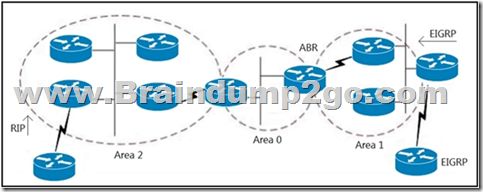
A. Make area 1 a NSSA.
B. Make area 1 a stub.
C. Make area 1 a standard OSPF area.
D. Make the area 1 routers part of area 0.
Answer: A
Explanation:
Area 1 should be an NSSA because of the ASBR advertising EIGRP routes.
QUESTION 106
An engineer must propose a solution for a campus network that includes the capability to create multiple Layer 3 virtual networks. Each network must have its own addressing structure and routing table for data forwarding. The solution must be scalable to support hundreds of virtual networks and allow simple configuration and management with minimal administrative overhead. Which solution does the engineer recommend?
A. hop-by-hop EVN
B. multihop MPLS core
C. multihop IPsec tunneling
D. hop-by-hop VRF-Lite
Answer: D
Explanation:
Table 1 Network Virtualization Technique Comparison Chart

https://www.cisco.com/c/en/us/td/docs/solutions/Enterprise/Campus/Network_Virtualization/sccsolover.html
QUESTION 107
Refer to the exhibit. Which two solutions maximize the use of the links between the core and distribution layers? (Choose two.)
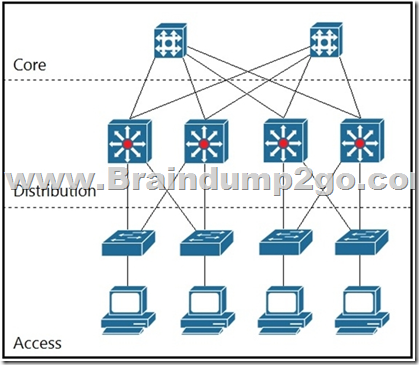
A. use multiple equal-cost links
B. use an IGP
C. use HSRP
D. use RPVSTP+
E. use multiple unequal-cost links
Answer: AB
QUESTION 108
An engineer is tasked with designing a dual BGP peering solution with a service provider. The design must meet these conditions:
– The routers will not learn any prefix with a subnet mask greater than /24.
– The routers will determine the routes to include in the routing table based on the length of the mask alone.
– The routers will make this selection regardless of the service provider configuration.
Which solution should the engineer include in the design?
A. Use a route map and access list to block the desired networks, and apply the route map to BGP neighbors inbound.
B. Use a route map and prefix list to block the desired networks, and apply the route map to BGP neighbors outbound.
C. Use an IP prefix list to block the desired networks and apply the IP prefix list to BGP neighbors outbound.
D. Use an IP prefix list to block the desired networks and apply the IP prefix list to BGP neighbors inbound.
Answer: D
QUESTION 109
An engineer is designing an EIGRP network for a small branch site where there is only one Layer 3 router. The engineer wants the router to advertise the local LAN network to remote EIGRP neighbors without sending any unnecessary multicast messages on the local LAN.
Which action should the engineer take?
A. Use a static default route for this site instead of EIGRP
B. Advertise the local LAN using the network command and the passive-interface feature
C. Redistribute the local LAN network using the redistribute connected command
D. Advertise the local LAN subnet as a stub network
Answer: B
Explanation:
The requirement is simply to advertise the network but NOT send MC traffic on the local LAN. For this you have to make it a passive interface. There are no requirements stated to make it a stub.
QUESTION 110
A network engineer is redesigning a company’s QoS solution. The company is currently using IP Precedence, but the engineer plans to move to DiffServ. It is important that the new solution provide backward compatibility with the current solution. Which technology should the design include?
A. expedited forwarding
B. assured forwarding
C. class selector code points
D. default per hop behavior
Answer: C
Explanation:
FiffServ is backward compatible with IP Precedence (Ip-Precedence uses the 3 most signifcant bits of the ToS byte, whereas Diffserve uses the fost significant six bits – which includ the ones from IP precedence).
QUESTION 111
A customer’s current Layer 2 infrastructure is running Spanning Tree 802.1d, and all configuration changes are manually implemented on each switch. An architect must redesign the Layer 2 domain to achieve these goals:
– reduce the impact of topology changes
– reduce the time spent on network administration
– reduce manual configuration errors
Which two solutions should the architect include in the new design? (Choose two.)
A. Implement Rapid PVST+ instead of STP.
B. Implement MST instead of STP.
C. Use VTP to propagate VLAN information and to prune unused VLANs.
D. Configure broadcast and multicast storm control on all switches.
E. Configure dynamic trunking protocol to propagate VLAN information.
Answer: AC
QUESTION 112
How is sub-second failure of a transport link detected in a Cisco SD-WAN network?
A. Hellos are sent between the WAN Edge routers and the vSmart controller.
B. BFD runs on the IPsec tunnels between WAN Edge routers.
C. BGP is used between WAN Edge routers and the vSmart controller.
D. Link state change messages are sent between vSmart controllers.
Answer: B
Explanation:
https://www.cisco.com/c/en/us/td/docs/routers/sdwan/configuration/Monitor-And-Maintain/monitor-maintain-book/m-network.html
BFD Protocol
The Role of BFD in Cisco SD-WAN Solution
The BFD protocol detects links failures between routers. It measures data loss and latency on the data tunnel to determine the status of the devices at either end of the connection.
For data plane resiliency, the Cisco SD-WAN software implements the BFD protocol, which runs automatically on the secure IPsec and GRE connections between routers. These connections are used for the data plane, and for data traffic, and are independent of the DTLS tunnels used by the control plane.
QUESTION 113
Refer to the exhibit. An architect must design a solution to connect the network behind R3 with the EIGRP network. Which mechanism should be included to avoid routing loops?
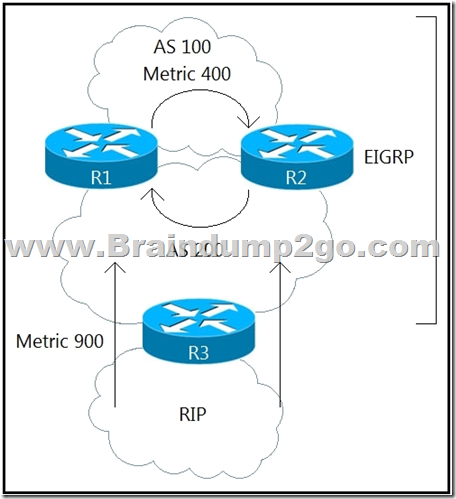
A. down bit
B. split horizon
C. route tags
D. summarization
Answer: C
Explanation:
https://www.ciscopress.com/articles/article.asp?p=1763921&seqNum=5
QUESTION 114
Drag and Drop Question
An engineer must design an addressing plan for a small business using a single /24 network. Each department must have its own subnet. Drag and drop the subnets from the left onto the
departments requirements that they fulfill on the right. Not all options are used.
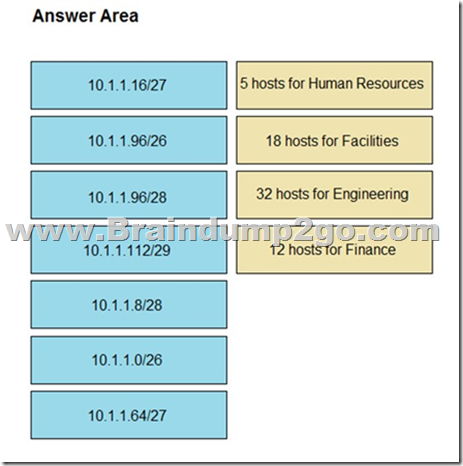
Answer:
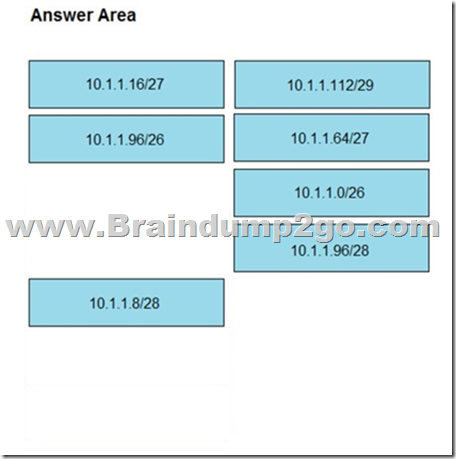
QUESTION 115
Drag and Drop Question
Drag and drop the characteristics from the left onto the Yang model they describe on the right.
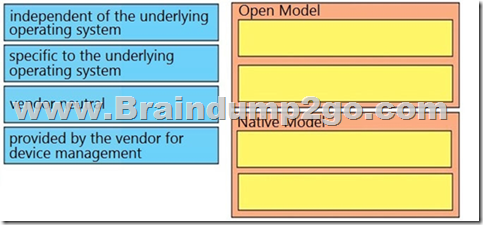
Answer:
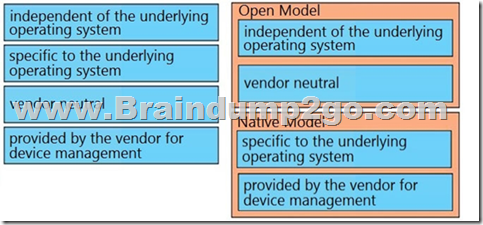
QUESTION 116
Drag and Drop Question
Drag and drop the model driven telemetry characteristics from the left onto the mode they belong to on the right.
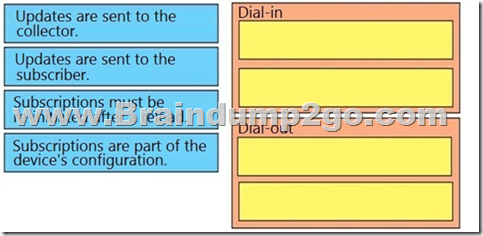
Answer:
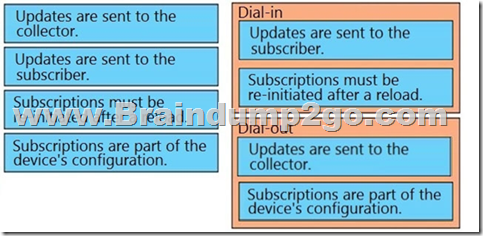
QUESTION 117
A customer has several remote sites connected with their headquarters through microwave links. An engineer must propose a backup WAN solution based on these conditions:

Which backup WAN link type the engineer recommend?
A. LTE
B. 802.16 WiMAX
C. Laser link
D. 802.15.1 Bluetooth
Answer: A
QUESTION 118
How is internet access provided to a WAN edge router that is connected to a MPLS transport link?
A. OMP advertises a default route from a WAN Edge router that is connected to the MPLS and internet transport networks
B. Internet access must be provided at the WAN Edge router through either a 4G/5G link or local Internet circuit
C. An extranet must be provided in the MPLS transport network to allow private traffic to reach the public internet
D. TLOC extensions are used to route traffic to a WAN Edge router that is connected to the Internet transport network
Answer: D
Explanation:
https://www.ciscolive.com/c/dam/r/ciscolive/us/docs/2018/pdf/BRKRST-2091.pdf
QUESTION 119
A network engineer must segregate three interconnected campus networks using IS-IS routing.
A two-layer hierarchy must be used to support large routing domains and to avoid more specific routes from each campus network being advertised to other campus network routers automatically.
Which two actions does the engineer take to accomplish this segregation? (Choose two.)
A. Designate two IS-IS routers as BDR routers at the edge of each campus, and configure one BDR for all Level 1 routers and one BDR for all Level 2 routers.
B. Designate two IS-IS routers from each campus to act as Level 1/Level 2 backbone routers at the edge of each campus network.
C. Assign the same IS-IS NET value for each campus, and configure internal campus routers with Level 1/ Level 2 routing.
D. Utilize different MTU values for each campus network segment. Level 2 backbone routers must utilize a larger MTU size of 9216.
E. Assign a unique IS-IS NET value for each campus, and configure internal campus routers with Level 1 routing.
Answer: BE
QUESTION 120
Refer to the exhibit. All routers currently reside in OSPF area 0. The network manager recently used R1 and R2 as aggregation routers for remote branch locations and R3 and R4 for aggregation routers for remote office locations. The network has since been suffering from outages, which are causing frequent SPF runs. To enhance stability and introduce areas to the OSPF network with the minimal number of ABRs possible, which two solutions should the network manager recommend? (Choose two.)
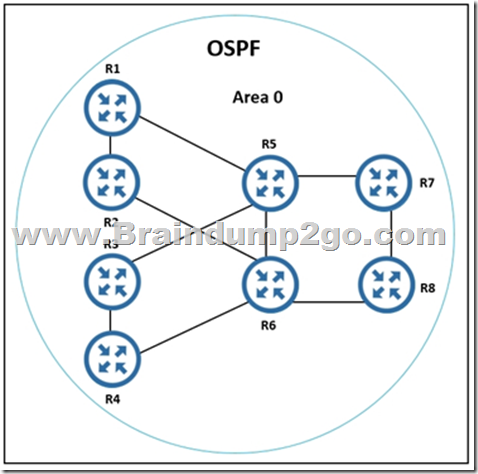
A. a new OSPF area for R1 and R2 connections, with R1 and R2 as ABRs
B. a new OSPF area for R3 and R4 connections, with R5 and R6 as ABRs
C. a new OSPF area for R3 and R4 connections, with R3 and R4 as ABRs
D. a new OSPF area for R1, R2, R3, and R4 connections, with R1, R2, R3, and R4 as ABRs
E. a new OSPF area for R1 and R2 connections, with R5 and R6 as ABRs
Answer: BE
Resources From:
1.2023 Latest Braindump2go 300-420 Exam Dumps (PDF & VCE) Free Share:
https://www.braindump2go.com/300-420.html
2.2023 Latest Braindump2go 300-420 PDF and 300-420 VCE Dumps Free Share:
https://drive.google.com/drive/folders/1SXwfGxRyjBzcw1iBNd9T4FhKWBoH7WUo?usp=sharing
Free Resources from Braindump2go,We Devoted to Helping You 100% Pass All Exams!